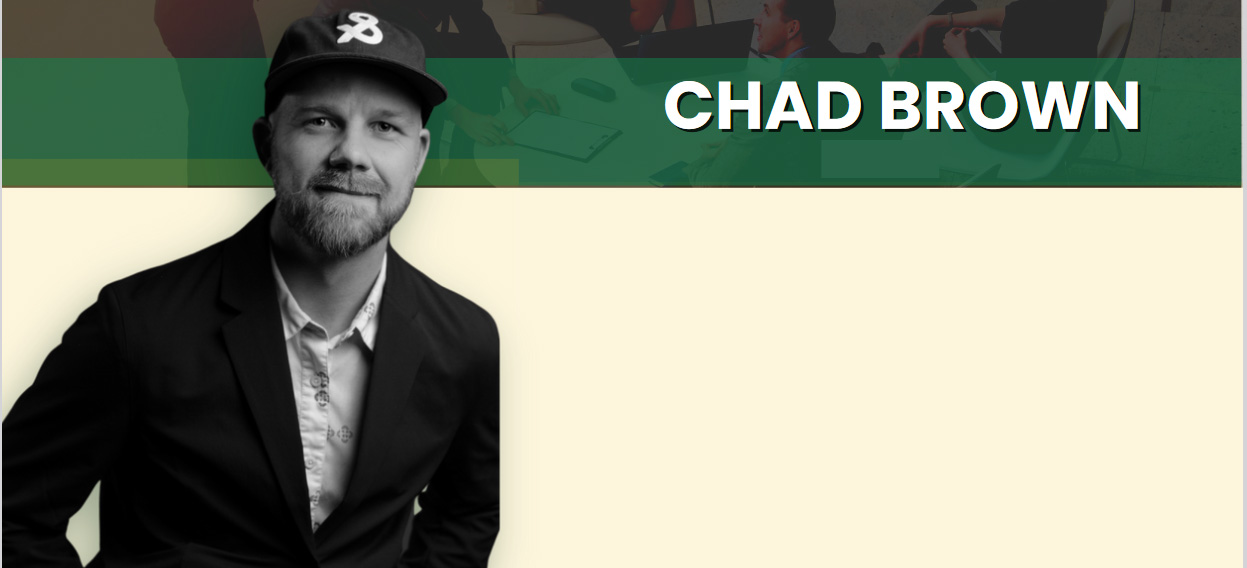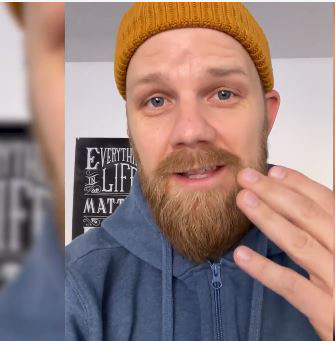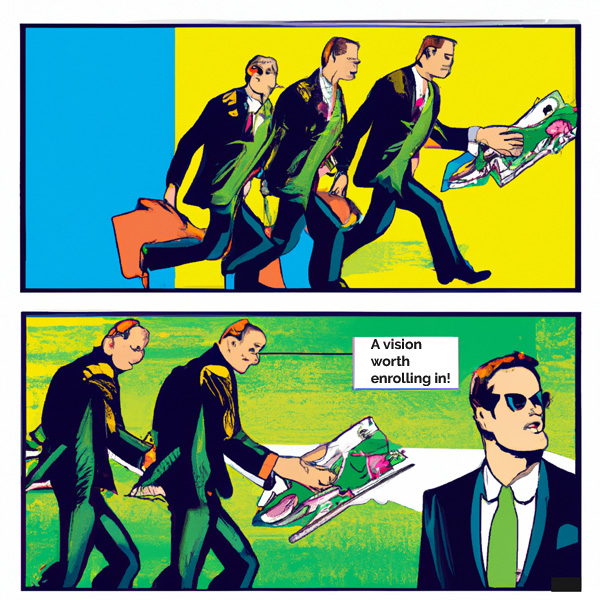Thought Leadership Studio Podcast Episodes:
Interview with Chad Brown
Episode 37- Leading as a practice, the power of story-telling, and more from Chad Brown of Take New Ground.

#coaching, #customerexperience, #insight, #interviews, #leadership, #motivation, #storytelling, #thoughtleadershipexamples
Or Click here to listen or subscribe on appWhat this episode will do for you
- Gain insight into Chad Brown's perspective of Leadership as a Practice.
- Learn Chad's two reasons people are in business.
- Dive into Chad's perspective on how and why story-telling is necessary to engage and audience.
- Learn how to align the various stories of team members under a unifying purpose while also allowing individuals to express their own vision.
Chad Brown, Leadership Engagement Expert.
Chad Brown coaches executives and entrepreneurs in the art and science of leadership for themselves, their teams, and clients to create new, unprecedented results and experience fulfillment in their work.
Chad is an Associate Partner at Take New Ground and the host of the The Naked Leadership Podcast with the founding partners of TNG.
Chad founded a media production studio called Shade Tree Films in 2008 that has serviced global companies such as Volkswagen, Target, and Pixar Animation Studios. This is where his love and passion for leadership and causing results through others was ignited. He thrives in the extreme environments and finds comfort in difficult conversations. Over the last 5 years, Chad has trained and
developed leaders at globally recognized brands like Lulu Lemon, and Ironclad Document Services along with many burgeoning start ups.
When he is not engaging in meaningful conversations with leaders, you will find (or wont find) Chad on a wild adventure in the mountains with his family. He resides at the foot of the Rocky Mountains in Orem Utah with his wife Katie and three children Addison, Kenya, and Milo.
Curated Transcript of Interview with Chad Brown
The following partial transcript is lightly edited for clarity - the full interview is on audio. Click here to listen.
Chris McNeil: I'm Chris McNeil, host of Thought Leadership Studio, and I am sitting here with leadership engagement coach and expert Chad Brown, who's an associate partner of Take New Ground. He's involved in the Intrepid Academy of Effective Leadership and he helps leaders figure out how to create results with other people. Welcome Chad.
 Chad Brown: Chris, it's so great to be here. How are you?
Chad Brown: Chris, it's so great to be here. How are you?
Chris McNeil: I'm doing great. So where are you coming from? I'm in Charleston, South Carolina.
Chad Brown:]I love Charleston. That's one of my favorite places on earth. The food is unbelievable.
Chris McNeil: Yeah, great food for sure.
Chad Brown: Today I'm coming from downtown Austin. I'm out here for South by Southwest, and doing a couple of speaking engagements out here and kept taking a couple of meetings and working with actually one of our clients out here that has an activation as well. So it's been a good time.
This is my last day here. I am on the tail end of, you know, how conferences can be. So energy is still good, luckily, and I've had a great time, made some really meaningful connections. But yeah, so I'm downtown Austin now. I reside in Salt Lake City, well, just south of Salt Lake City, Utah. So happy to be here.
Chris McNeil: That's fantastic. So you do speaking, you do coaching, you do consulting. Where do you find your strongest sense of mission? And you can give me a specific example where that really connects with what's important to you?
Mission and Leadership as a Practice
Chad Brown: Yeah, for me, where I find my mission in the work that I do now is that I made a lot of mistakes in the past... I've had a lot of failures in my leadership. And seeing the results of those failures for both myself and the people that work for me or work with me really motivated me to figure out this whole leadership thing.
And once I started down that journey, I would not say I have it figured out now. I think that would be a misnomer. I think we're figuring it out the rest of our lives. I believe it's a practice. Most of the stuff that I engage in my life now is on a practice basis, not a figuring or an answer basis. But failure is not even the right word.
That those challenges in my past and my leadership had really driven me to the place that I am now, where it's such an art and science to leadership as, as you mentioned earlier, I call it, or, or the de definition I give to leadership is causing results through other people.
I went down that path based on my experience in a production company that I started in 2009. Made again, made a ton of mistakes, learned a lot of lessons, and just became very obsessed with this idea of how do we engage other people? How do we enroll other people to accomplish a common goal or a com or, or a common aim? And I love it. I absolutely love it. I'm fascinated with it, you know, much to the chagrin of my wife, I'm sure, I'm obsessed with it.
I listen to everything I can get my hands on. I read everything that I can get my hands on, and I talk it all the time. And, I love it because I think it is the only way anything meaningful happens in this world.
Chris McNeil: That's awesome. So what I'm getting are a couple things here. One is a belief that leadership is a practice.
Chad Brown: Yes.
Chris McNeil: And learning from feedback. You said you had failures.... You know, from a certain point of view, there's no failure, there's only feedback, but I know what you mean. We see what happens and we adjust things. And that has helped instill a sense of mission in you. And you enjoy immersing in the art and science of leadership that you would define by enrolling other people in a common goal or aim. What would you give me as a shining example in your own experience of enrolling other people in the common goal or aim?
Two Reasons People Are in Business
Chad Brown: Yeah, I mean, I think the best, one of the most tangible realms or context we can put this in is business, right? So people start businesses for multiple reasons, but most of the entrepreneurs and hard-driving people that I work with, and it can really boil down to a couple reasons. They start a business, one, to make money. I'm not shy about making money. I think making money is a great thing. I think there's a lot of good in the world we can do if we're financially savvy, if we're taking care of both of ourselves, and then we can, you know, have access to go out and take care of others in the world.
The, the other, so that would be, that would be considered an aim, right? Sure. We're here to make some money. We're here to be profitable.
Chris McNeil: Sure.
Chad Brown: The other aim that I find common with hard driving entrepreneurs or founders is to get their ideas into the world or their creations into the world. And that feels successful to them because it's a legacy in ways. If we can get something out there lasting that makes a difference for people, then we have a say in what our legacy is.
And so for me, it's very much the same way when I created the production company, is like, I fell in love with the idea that we could tell a story and that we could drive some emotion that caused people to take action, right? So the production company that I had - and am in the process of selling - worked with commercial companies.
We got to work with brands like Volkswagen, Pixar, animation studios, target, some really big stuff, and some really big brands and big projects. And the idea that we could tell a story, that we could help somebody feel something, and then they would do something because of that, that was a really intoxicating idea for me. And I became very obsessed with that for, for quite a while. And that was the other aim, right?
To to be profitable, to make money, take care of our family, take care of other people, and then also to get some goodness out into the world and make a change in that way.

Leadership- Leverage by Enrolling Others in Your Vision
And, you know, I could do it alone, but my impact is limited when I do it alone, when I do it alone, my impact is limited by my time. It's limited by my focus. It's limited by my energy, it's limited by my funds. So that's the reason we enroll other people into the aims, into the goals, or into the vision that we have, is because our impact can expand.
And ultimately, the, the potential is unlimited on our, on the expansion of our impact if we're able and willing to enroll other people into the vision. So when I talk about leadership being, you know, the idea of causing results through other people or enrolling other people into our aims or our visions, that's what I'm talking about. And really, it's expansion of impact.
Chris McNeil: That's powerful. So impact is important to you. And telling a story that helps someone feel something which adds value, of course, to the recipient and all those, that the impact, I mean, that's powerful. And that's what thought leadership is all about it. What are the components of that? If you had to describe the pieces of the puzzle that somebody wanting to engage others to enroll others and get them immersed into a story to tell together to make an impact, what would be the steps to take? Or how would you describe a way of thinking or being that would bring that about?
We're Storytelling Creatures
 Chad Brown: Yeah, we're storytelling creatures. We inherited our storytelling. It's the way that we relate to each other. It's the way that we rate, relate to the world. Um, and ultimately one of the, one of the key things, one of the unique things that I work with leaders on is how do we use story to impact our teams? And how are we paying attention to their stories as an individual? Mm-hmm. , so often we want to shortcut people, um, especially when we lead them, especially when we're trying to be profitable. There's so much stuff to get done. You know, the to-do list is never ending. And we bring a lot of people, a lot of leaders or, or business owners or business founders, bring people into their organization to relieve their to-do list. And if that is the purpose for bringing people in, you're going to miss that individual's, that human being's story, and they're gonna miss yours.
Chad Brown: Yeah, we're storytelling creatures. We inherited our storytelling. It's the way that we relate to each other. It's the way that we rate, relate to the world. Um, and ultimately one of the, one of the key things, one of the unique things that I work with leaders on is how do we use story to impact our teams? And how are we paying attention to their stories as an individual? Mm-hmm. , so often we want to shortcut people, um, especially when we lead them, especially when we're trying to be profitable. There's so much stuff to get done. You know, the to-do list is never ending. And we bring a lot of people, a lot of leaders or, or business owners or business founders, bring people into their organization to relieve their to-do list. And if that is the purpose for bringing people in, you're going to miss that individual's, that human being's story, and they're gonna miss yours.
And if we are missing each other's story, we're missing an opportunity to really fight for one another and for something meaningful. Meaning every person that works for me or with me, has their own personal vested interest in why they're there. They have their own story. They have their own vision for their life.
If I don't understand that story, I'm gonna miss how my company and how my work can contribute to their story. And if I miss that, then I don't have a team that fights for my success. I have a team that does what needs to be done, and then they go home at the end of the day. But if I'm connecting those stories, we're both fighting for each other's success. So we can't ignore the fact that we're all motivated, we make decisions based off of the stories that we hear, and more importantly, the stories that we tell ourselves.
So if you're listening to this and you're struggling to get your people to do something that you want them to do, or, you know, they're not keeping their commitments, or you're not having the success that you want to have, I would suggest slowing down for a moment and getting clear on why are they there? What is their story? What is their, I guess says, you know, Simon Sinek says, "What is their why?"
Get clear on what the vision is that they have for their life, and how your brand and your work that you're doing can contribute to that.
Chris McNeil: Well, that's awesome. So by having people engaged where you have shared values or shared core beliefs, maybe that allows diversity in the stories where people can unfurl their own vision, but you're unified on a higher level with a common purpose.
Chad Brown: Yeah, that's exactly right. I mean, I see, I see it all the time. So many business owners and founders, and I call them business owners and founders, not leaders for a reason. Because I think leadership is something we choose. It's not something we inherit by, by the nature of starting a company or having a title. And I think so many leaders, or so many business owners and business founders are, are concerned about their people's visions, because what if they don't?
What if their vision takes them away from what we're doing? Right? What if they, what if they're working for me as a data analyst, but their vision or their dream is to be an actor, an actress, and that can be a threat, that can feel like a threat to them because they have invested in these human beings to be there and do the work that they want them to do.
And what if they lose them? And, you know, all of that sort of stuff. And so they avoid this idea, this topic of what's your story? What's your vision? And I think that's a huge mistake. I think if your, if their time with you is a stepping stone towards their vision, that's a beautiful thing.
And you're actually gonna be more successful with human beings in those places that see that, you know, see their time with you as a stepping stone towards, or maybe they see it as their end all be all with you. But whatever it is, if you're connected to that and connecting it to the vision of the company, you're going to be way more successful.
Chris McNeil: That makes perfect sense. And I wonder what your thoughts are on how that dynamic plays out in an organization - maybe a service organization where the leader has a unifying vision, but there's this need for the people who actually interact with the customers, the front lines, who are going to be a little more forward facing in being in touch with what customers really want, and how that can weave into the story of the company.
So maybe this letting decentralized variations of a story unfurl from the front lines might help a company be more in touch with its customers.
Chad Brown: Absolutely. I mean, think about it. I had an experience yesterday. I'm out here in Austin, and there's a little restaurant that I love to go to when I'm here in Texas. There's a few of 'em in Texas called Kava, and it's a Mediterranean place, and it, it's kind of, you know, it's one of those where you go in and you pick your protein and you pick it if it's a bowl or a burrito or a salad, or, you know, all of that sort of stuff.
And, um, I got to talking with the, with the woman who was behind the counter, that's your first content contact. And she was so friendly, and she was so open, and she was, you know, inquiring about how my day was and what I was up to. And nothing overbearing. I get how sometimes I can be a little overbearing when you're just, you know, wanting to get your food.
But she was very in tune with me and we had a great conversation. She was giving me all these recommendations of where I should go in Austin for, for more food and for entertainment and opportunities and all of that kind of stuff. And, and I said, well, what about you? What do you like, what are you about? What do you wanna do? Or what, what are you up to? And she told me a little bit about her life, where she's going, what she hopes. She's a musician.
She's here in the city to make something happen with her music and finding opportunities there. And for me to be able to interact with a human being with a story, it made me love Kava's brand even more, because she wasn't trained to be a robot just taking orders on the other side of the counter. It was a human connection that we made. And it was more, to me, than just ordering my, you know, falafel bowl.
I got to see a human and it re it reinforced my love for the brand and for the food and my experience there.
Chris McNeil: That's interesting. And, and how does that humanness of relating to a brand through its people being allowed to be people play out with the need a leader might feel, "Let's get everybody unified under a message, so we have a story to tell as a brand."
Chad Brown: Yeah, it's a great question, and sorry if you already asked that and I missed it. I'm now realizing that that's possible. I'm very much in opposition to black and white thinking, to myopic thinking like it's this or that.
I have a line of hats that I wear. I mean, this is audio, so people can't see it, but all of my hats that I wear have an ampersand on them and of course stands for "and". And it's a constant reminder, both for me and for my clients when I'm on a coaching call with them, or we're in an offsite or whatever, it's a consistent reminder to remind them that both can be possible if you find yourself choosing between this or that.
The question I would invite you to ask yourself is, how could you have both? How could both exist together? And that's the leaders who are wondering that same thing. I would ask the same question. How could you both have individuals with dreams, visions, stories, and enroll them into a common, or as you're, as you say, a unified story or brand representation? I believe both are very, very much possible. In fact, I believe the story of your brand, the story of your product or your service and your leadership is stronger when you have individual stories that can align with it.
Chris McNeil: Well, maybe that, that seems to tap into, a way of thinking, I might call, openness of a brand that is about developing relationships with customers. And through those relationships, the customers can discover their needs better, because there's the trust that comes from the humanness and people being people and not being quite as confined.
And that confinement, I guess, can be an obstacle. That ampersand that, that brings up the thought, do you run into limiting beliefs in people who want to develop their leadership and the need to learn to question your own thinking a little bit about what leadership is in order to have that ampersand principle more at work?
Chad Brown: Right on. I mean, this comes back to the idea of practice, because I believe practice, if we're truly practicing something, you think about it in the traditional sense of sports or in playing an instrument or whatever.
What do we think of when we think of practicing? Well, there's lower pressure for one, this is just a practice, right? So mistakes are welcome here - and challenges, we're gonna challenge ourselves, but we're also gonna take the feedback from the challenge. And hopefully anytime you're practicing, not anytime, but hopefully there are windows of your practice where you have a coach. And it's really easy for us to think about this in the sense of music and sports. It's like, yeah, of course, your coach is gonna be at your practice so that they can see what your not seeing. They're going to see the blind spots and then help you see them in a way that you can then apply the learnings.
So I would say, you know, the practice principle has been so powerful for me because if I'm practicing, then I'm constantly seeking coaching. I'm constantly seeking feedback and wondering, Hmm, what is it that I'm missing here? And who can help me see it? And if I have that attitude, if I have that perspective, I believe I can accelerate the, my success, I can accelerate my progress, or progression because I'm getting more eyes on it. Sure. And I'm getting the opportunity to hear the perspective of other people. So, um, right on. I would say one of those, one of those elements of practice is like, find coaching, find feedback, and hear it, and listen to it as often as you possibly can.
.............
The transcript is lightly edited for clarity and is a partial transcript- the full interview is on audio. Click here to listen.
***************************************
Free Stuff and Offers Mentioned in Podcast
***************************************
***************************************